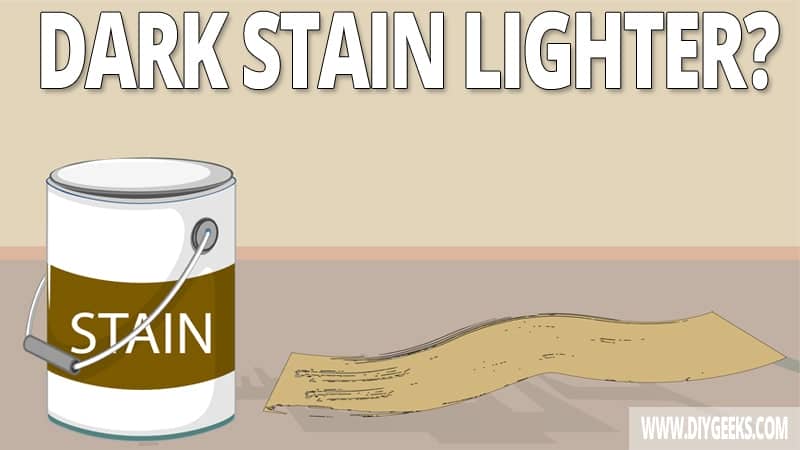Lightening stained wood refers to altering the color of previously stained wood to make it less dark.
To lighten stained wood, remove a layer of wood stain using fine-grit sandpaper, or apply wood bleach, vinegar, acetone, or mineral spirits. The sandpaper will reduce the amount of pigments on the surface and lighten the finish.
While, wood bleach, vinegar, acetone, or mineral spirits will remove a few layers of stain from the surface, making the overall finish look lighter.
Key Takeaways
- You can lighten dark wood by removing a layer of stain with fine-grit sandpaper or applying wood bleach.
- Thinning the stain before applying it will make the finish lighter.
- Water-based polyurethane can also make the finish appear lighter. That’s because its glossy finish will reflect light.
- You can also use mineral spirits, vinegar, steel wool, or acetone to remove a few stain coats and make it appear lighter.
Is It Possible To Make Dark-Stained Wood Lighter?
It is possible to make dark-stained wood lighter by sanding it with fine-grit sandpaper or by using wood bleach, vinegar, acetone, or mineral spirits.
The sandpaper, an abrasive paper or cloth used to smooth or polish surfaces, will remove one or more coats of wood stain off the surface, making the finish look lighter. Once one coat is removed, the stain will have fewer pigments on the surface, making it appear lighter.
The more you sand the wood stain finish, the lighter the color shade will be. But, if you sand it too much, you can remove the entire finish and leave a bare wood surface behind.
You can also make the wood finish appear brighter by applying wood bleach over it. Wood bleach, which is mainly used as a cleaning agent, can also be used as a lightening agent for darker finishes. However, wood is a porous material and can get damaged if you apply too much bleach to it.
You can make sealed stained wood lighter by removing some sealer coatings with medium-grit sandpaper, or paint-stripping paste. Once the sealer top coating is removed, the stained wood color will appear lighter.
How To Lighten Wood Stain Before Applying It?
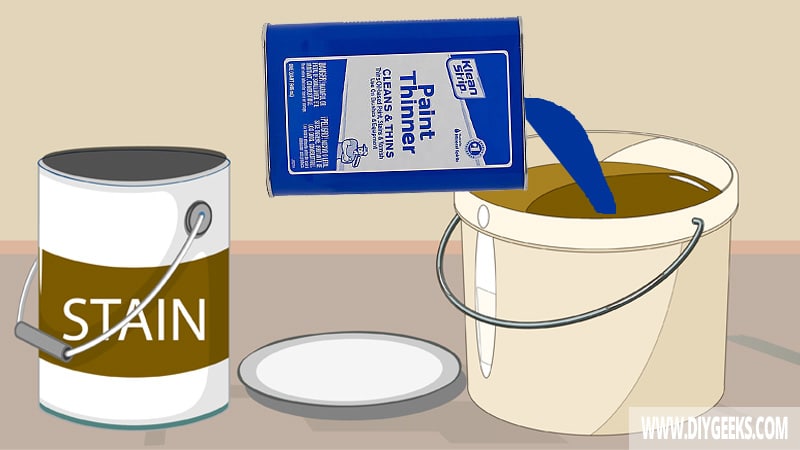
To lighten the wood stain before applying it, thin it using water or mineral spirits. Thinning stain increases the amount of solvent in the formula compared to the pigment (or color), this makes its coatings lighter.
To thin oil-based wood stains (all types), use mineral spirits. To thin water-based stains, use water. The recommended thinning ratio is 1:4 (1 part thinning compound to 4 parts of stain). You can use a higher ratio, such as 2:4 (2 parts thinning compounds to 4 parts stain), to make its color even lighter.
Here’s how to do it:
- Pour the needed amount of wood stain into a clean bucket.
- Based on the amount of wood stain you added, measure the right amount of paint thinner. Use a 1:4 or 2:4 thinning ratio.
- Use a stick to stir for a few minutes.
- Test the mixture to see if it’s light enough.
Another method is to use a wood or pre-stain conditioner. Wood conditioner, a finish that helps the surface to absorb the stain evenly, results in a more uniform color shade. Use a wood conditioner before applying wood stain if you are working with a porous or uneven wood surface.
How To Lighten Wood Stain After Applying?
To lighten wood stain after applying, do the following.
- Prep Your Work Area
- Remove The Top Layer
- Sand The Finish
- Apply Wood Bleach
- Seal The Finish
Brightening a coating after applying it is harder, as you must either sand, bleach, or seal it to change its color.
The tools you need for this project are listed below.
- Wood bleach.
- A bristled-paintbrush.
- Fine-grit sandpaper or sanding block.
- A top coat.
- A bucket of water.
- Baking soda.
- A drop cloth.
- A pair of work gloves.
- A scrubbing brush.
- Painter’s tape.
- Chemical-based paint stripper.
- An orbital sander (for large wooden surfaces).
2. Remove the Topcoat (If Any)
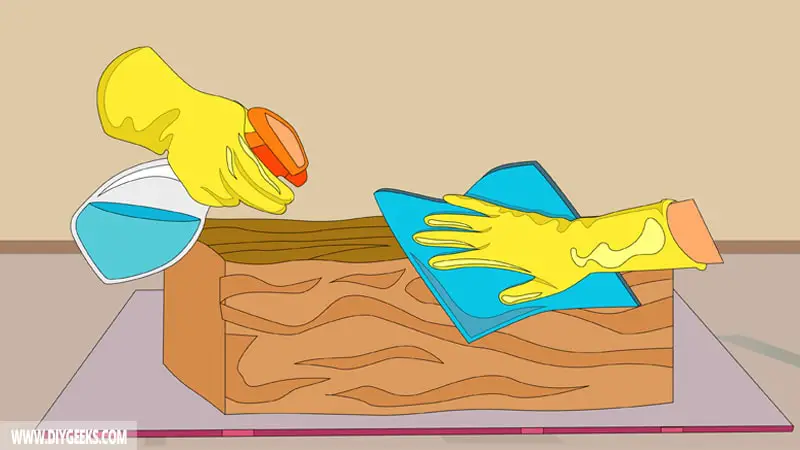
If the wood stain finish is sealed with a topcoat, remove it as it can prevent the sandpaper or wood bleach from lightening the finish.
To remove the sealer over wood stain, do the following things.
- Apply paint-stripping paste.
- Wait around 30 minutes.
- Scrape the paint-stripping paste and the sealer coating will get removed too.
- Clean the finish with warm soapy water.
If the wood stain finish isn’t sealed, you can skip this step.
3. Sand the Finish
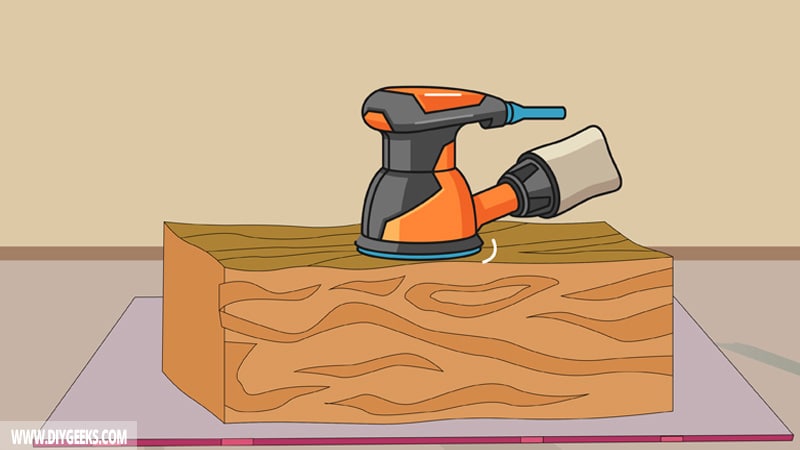
Sand the wood stain finish with ultra fine-grit sandpaper (440-grit) to remove surface imperfections and bumps, and remove some wood stain from the surface to reveal a lighter finish.
After sanding, remove the dust and inspect the finish to see if the color shade is lighter. You can use fine-grit sandpaper (220-grit) to remove more wood stain and get a lighter color shade.
Don’t use coarse or medium-grit sandpaper (40/100-grit) as it can remove the entire wood stain finish.
4. Apply Wood Bleach
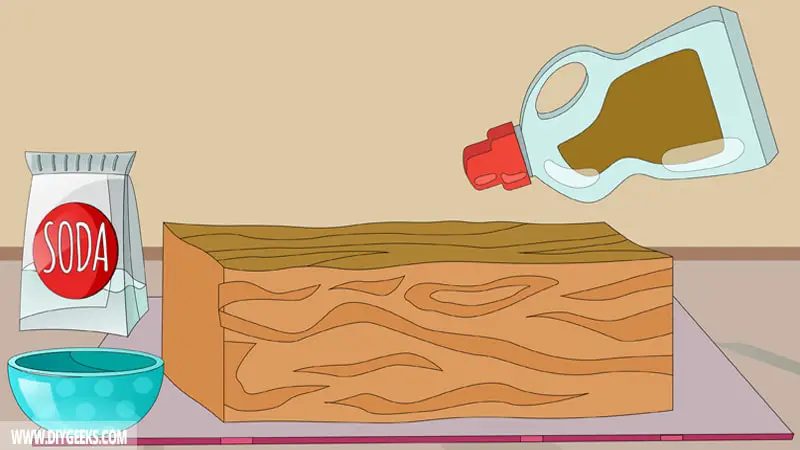
Apply wood bleach over the finish using a paintbrush and wait around 15 minutes before removing it. The wood bleach will fade the finish within 15 minutes and make it appear lighter.
To remove the wood bleach, mix baking soda with water and use it to rinse the finish two times. Baking soda will remove the bleach residue that can damage or discolor the wooden surface.
Next, inspect the finish to see the color shade. The finish should be lighter now since you removed the top coat, sanded the finish, and bleached it. If you want a brighter finish, you must either do all the steps again (sand & bleach) or remove the entire finish and apply a lighter color shade.
5. Seal The Finish
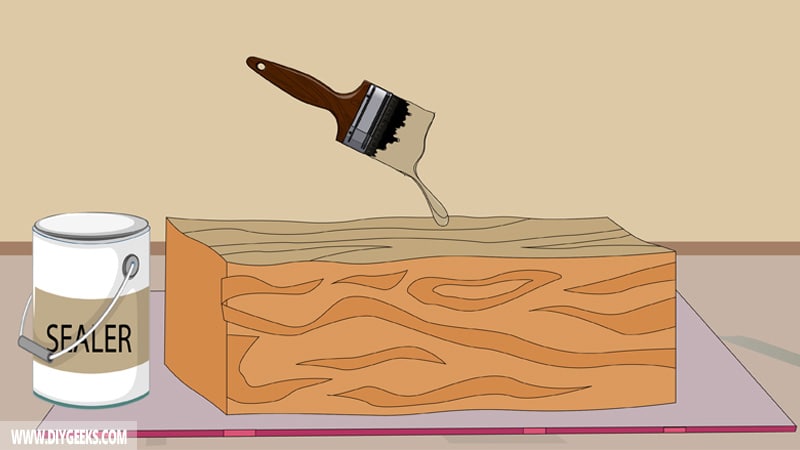
Seal the finish after you lighten it to protect it from moisture, water, scratches, or weather elements.
Related: How To Darken Stained Wood?
Other Methods To Use:
Other methods to use are listed below.
1. Use Mineral Spirits
Mineral spirits, also known as white spirits, is a petroleum-derived liquid that is used as a solvent for painting. Its content helps to fade or remove a finish.
To use mineral spirits, soak a clean rag in the solvent and wipe the finish with the dampened rag. As you wipe, the stain coating will start to come off on the rag. Do this a few times until the finish appears lighter.
This works for oil and water-based wood stains. You can use turpentine as an alternative to it.
2. Vinegar
Vinegar is a combination of acetic acid and water that may include flavoring. It’s mostly used as a household product, but you can also use vinegar to remove paint or brighten a finish.
To brighten a water-based stain finish, pour vinegar directly over it and spread it using a paintbrush or a rag. Wait a few minutes before cleaning it off. The finish will look brighter after this.
3. Acetone
Acetone is a colorless organic compound with a formula of (CH₃)₂CO. It’s one of the main ingredients of nail polish or paint remover. You can use acetone to fade a darker finish but only use it for glossy wood stains, such as gel or lacquer.
Glossy wood stains are moisture-resistant and harder, meaning it would be difficult to brighten them with regular solvents. Since acetone is a strong natural paint remover, you can use it. However, don’t use too much of it as it can range the entire coatings.
Also, don’t use acetone to brighten regular wood stains, such as oil or water-based. That’s because it will remove the entire coating instead of brightening it.
4. Steel Wool
Steel wood is created by a bundle of interwoven steel fibers, and it’s mainly used for cleaning and polishing. It’s similar to sandpaper — it removes a few layers off the surface and makes it appear lighter. Once the layers are removed, the surface will have fewer pigments on it and the finish will appear lighter.
To use it, soak a 0000-grit super fine steel wool in warm water and use it to remove the top layer of the finish by running it along the grain. After using it, remove the dust, inspect the finish, and re-do the whole process if needed.
[su_youtube url=”https://www.youtube.com/watch?v=q05VDlUJNdU”]
Can You Lighten Stained Wood Without Sanding?
You can lighten stained wood without sanding by using 0000-grit super fine steel wool and warm water. This will remove the top layer from the finish, making it appear brighter.
You can also use a chemical-based paint stripper. The paint-stripping compound will remove a few coatings from the finish, making it appear brighter. However, only use the stripping compound for oil-based stains. If you use it for water-based stains, you will remove the entire finish.
You can also try whitewashing the stain to make it lighter. This method includes mixing regular white paint with lots of water and applying it directly over the surface. The white paint will give a lighter shade to the finish underneath. But, whitewash is commonly used after bleaching or sanding the wood stain.
FAQ’s
Will Polyurethane Brighten a Finish?
Water-based polyurethane will brighten a finish because its finish is clear (transparent) and allows light to pass through. This makes the finish appear brighter since it reflects light.
However, oil-based polyurethane doesn’t brighten a surface because it has a high volume of oils and it gives a yellow tint.
Does Wood Stain Lighten Over Time?
Yes, the wood stain does lighten over time — especially if it’s placed outdoors. When the finish comes in contact with dust, UV lights, it will start to lose its color — especially oil-based stain. However, this can take a while and the finish will look blotchy when that happens.
Does a Lighter Wood Stain Finish Mean less Protection?
A lighter finish means less protection only if you lighten it after you apply the wood stain. This is because if you remove layers of wood stain from a surface using bleach or sanding, the surface will have less protection than it did before.
However, wood stain doesn’t offer high protection to a surface whether you remove some layers or not. It’s recommended to seal it if the surface is placed outdoors.
